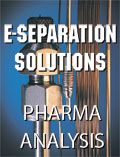The LCGC Blog: Intact Protein Separations: Some Education Is Missing
E-Separation Solutions
I will preface this blog installment by saying that I am not an expert on separation of proteins, but I am learning. What I do understand are the fundamentals of chromatography for small molecules. This information abounds, but it is much more difficult to find the same level of information for biomacromolecule chromatography.
I will preface this blog installment by saying that I am not an expert on separation of proteins, but I am learning. What I do understand are the fundamentals of chromatography for small molecules. This information abounds, but it is much more difficult to find the same level of information for biomacromolecule chromatography. A couple of years ago, we became interested in the separation of proteins in conjunction with the development of a new ambient ionization source (1). Since then, we have expanded our more traditional instrumentation base, and this has included a desire to incorporate intact protein separations into work flows for trace quantitative analysis using liquid chromatography–mass spectrometry. A lot of that effort is still in the developmental stage in our group, and we are on the verge of reporting some aspects that I think will be very intriguing to the scientific public; however, that is not the topic I wish to write about at the moment.
When we began our interest in intact protein separations, I started to ask around about the general availability of information pertaining to chromatographic fundamentals. Many said it does not exist - even those who were practicing protein separations. I found that hard to believe and I have subsequently found many helpful references that I will share in the text below, but it is certainly not abundant. It is clearly a missing piece of information in our education of the next generation of chemists; I know of no mainstream analytical textbook that deals in a reasonably detailed fashion with specific retention mechanisms and, for example, van Deemter theory associated with intact protein chromatography. With an expanding interest on (and monetary backing for) biomarker discovery and diagnosis and the development of protein pharmaceuticals, there appears to be a missing educational link. Current researchers need to learn on the job. Thankfully, there are more and more resources becoming available, including webinars and tutorials; yet, more efforts are needed to get critically useful and practical information to our current students, before they go out into the work world.
I had the opportunity of hearing a presentation on the current state and future of chromatography by the late Prof. Georges Guiochon at the Conference on Small Molecule Science (CoSMoS) this past summer in Williamsburg, Virginia. I was eager to hear his insightful view of where the field is heading. I was not disappointed, but I noted one interesting comment. A while back, he had considered delving substantially into protein separations, but he ultimately deemed the problem to be too complex. That is a shame given the high demand for these methods today - it would have been wonderful to have a body of work from his lab in the scientific literature on this topic. Of course, we have all benefited greatly from his other efforts, but his statement on protein separations was telling. If Guiochon considered this to be a very challenging research topic, then what was I getting into? Some other guidance I received from other senior researchers was not very specific. “Take it slowly,” they said. They did not mean the research. They meant the chromatography, but it was not clear to me what that meant from a fundamental chromatography perspective. It was not until Guiochon said in his talk that optimal linear velocities for efficient protein separations are approximately 5–10 times lower than that for small-molecule separations. When you think about it, this makes sense. But in the modern world of ultrahigh-pressure liquid chromatography (UHPLC), where the use of small-diameter particles and instruments capable of going to higher pressures persuades researchers to go faster rather than slower, I could see a disconnect that many researchers might not appreciate.
In van Deemter theory, you have the “A-term” (multiple flow paths), the “B-term” (longitudinal diffusion), and the “C-term” (mass transfer), all of which you ideally minimize to get maximum efficiency (or minimal plate heights). The A-term is invariant with linear velocity of the mobile phase and depends on column packing and particle diameter. The B-term is inversely proportional to linear velocity and proportional to the diffusion coefficient for an analyte in the mobile phase. Thus, the longer an analyte is in the column (using lower linear velocities), the more it can diffuse and contribute to band broadening. However, large proteins will have small diffusion coefficients, so this is less of a concern. The C-term is proportional to linear velocity. The faster the analyte is pumped through a column, the more band broadening can result as some of the analyte lags behind in the stationary phase and some is swept ahead in the mobile phase. Furthermore, mass transfer for proteins is slow; deleterious effects of mass transfer for proteins would be accentuated at higher flow rates. Thus, we can reason that mass transfer is a major contributor to the significantly lower optimal linear velocities needed to obtain the highest efficiency separations for large proteins compared to small molecules.
When you look more closely back in the literature, you can find some informative articles that corroborate Guiochon’s assertion, the reasoning above, and other core considerations (2–5). If we restrict our discussions to reversed-phase retention of large proteins, we can also begin to understand that the multifunctional nature of proteins makes them subject to more complex stationary phase interaction mechanisms compared to small molecules (6). A protein has multiple hydrophobic units that can interact with the stationary phase, but it also contains multiple side-chain units from amino acids such as lysine, histidine, and arginine that can interact with silanol units. The protein does not gradually walk down the column, like a small molecule. It is probably more or less immobile until the proper mobile-phase condition is reached for elution. Increased column temperature can help lessen the multitude of interactions (7). Also, the mobile-phase composition and temperature can cause the protein to change conformations while on the column (8). If the gradient is ramped too quickly to a high organic content, there is the potential to reinforce hydrophilic interaction modes, which will inhibit elution. Direct use of hydrophilic interaction liquid chromatography (HILIC) has also been investigated for intact protein separations, among many other modes (9). “Take it slowly” appears to refer not only to the flow rate, but also to the ramp rate used in gradient elution modes.
I was also privileged to recently hear a plenary lecture by Pat Sandra on biopharmaceutical analysis at the International Symposium on Chromatography (ISC) in Salzburg, Austria this fall. The analytical demands in this area are many - many strategies are needed to evaluate protein sequence, charge variants, aggregation, glycosylation, disulfide bridging, deamination, oxidation, and clipping, among other properties (10). This range of strategies includes multiple chromatography and mass spectrometry techniques. In the next 5–10 years, the protein pharmaceutical market is expected to exceed $150 billion. Many manufacturers will be focused on development of biosimilars and biobetters to augment their portfolios and competitiveness, and these developments will require more stringent quality control measures. Quantitative analysis of these drugs through development and clinical use will also be a major challenge, and new analytical methods will need to be developed. Universities need to take a close look at what they are teaching their students, to make sure that they provide the most up-to-date information, as well as the proper foundational education, to ensure that students are ready to enter this work world and contribute intellectually and intelligently. Guiochon was right - protein separations are quite complex. Small-molecule chromatographic theory can be quite straightforward, but analysis of proteins requires a much wider breadth of knowledge and understanding of appropriate techniques and approaches. Further, manufacturers continue to innovate and provide new separation materials; these will have different performance properties than materials reported on a decade or more ago. I am finding it fascinating to investigate and hope our group can soon contribute our own advancements and insights on the topic into the scientific literature.
References
(1) S. Yang, A.B. Wijeratne, L. Li, B.L. Edwards, and K.A. Schug, Anal. Chem.83, 643–647 (2011).
(2) J.M. DiBussolo, Amer. Biotech. Lab.2, 20–34 (1984).
(3) M.W. Dong, J.R. Gant, and B.R. Larsen, BioChromatography4, 19–34 (1989).
(4) E.G. Burton, K.D. Nugent, T.K. Slattery, B.R. Summers, and L.R. Snyder, J. Chromatogr.443, 363–379 (1988).
(5) K.D. Nugent, E.G. Burton, T.K. Slattery, B.F. Johnson, and L.R. Snyder, J. Chromatogr.443, 381–397 (1988).
(6) R.L. Cunico, K.M. Gooding, and T. Wehr, Basic HPLC and CE of Biomolecules (Bioanalytical Laboratory, Inc., Richmond, California, 1998).
(7) F.D. Antia and C.S. Horvath, J. Chromatogr.435, 1–15 (1988).
(8) X.M. Lu, K. Benedek, and B.L. Karger, J. Chromatogr.359, 19–29 (1986).
(9) A. Staub, D. Guillarme, J. Schappler, J.-L. Veuthey, and S. Rudaz, J. Pharm. Biomed. Anal.55, 810–822 (2011).
(10) K. Sandra, I. Vandenheede, and P. Sandra, J. Chromatogr. A1335, 81–103 (2014).
The LCGC Blog: Historical (Analytical) Chemistry Landmarks
November 1st 2024The American Chemical Society’s National Historic Chemical Landmarks program highlights sites and people that are important to the field of chemistry. How are analytical chemistry and separation science recognized within this program?


